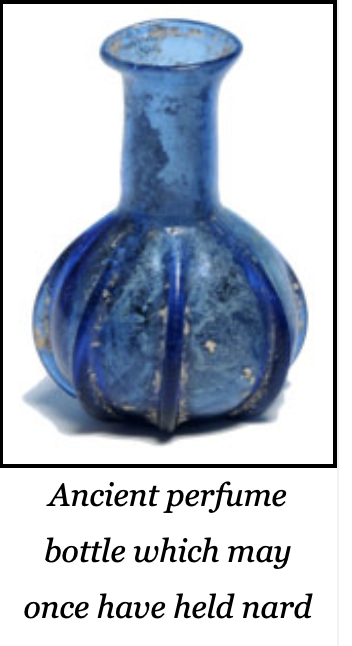
Women in general have the sense of the person much more than men have. This means that they have a special mission, which is to reintroduce love, to give back its humanity to a world which remains so glacial when men alone have built it.
Paul Tournier, The Naming of Persons, trans. Edwin Hudson (New York, N.Y.: Harper & Row, 1975), 86.
It’s the sixth day before Passover. In John 12:1-8, there was the Chief Priests and the Pharisees, and we are at the home of Lazarus in Bethany, where Martha served both Jesus and Lazarus. Why is Lazarus the favoured one? Well , in the previous Chapter he was the one restored to life: from his tomb came Lazarus holding onto his burial sheet: once proclaimed dead and now very much alive. The tomb can’t be sealed.
He stinketh.
Go on, you don’t believe me do you….John 11:39
Perhaps that’s why the Chief Priests are in town, to check out, to verify the story for they felt that he had never really died. They called it revivification.
Mary arrives
And here enters Mary, carrying a very heavy jar of perfume, typically sourced from India, not your local stuff, and pours it all over Jesus’ feet. It’s called Spikenard or more simply nard.
“The place smelled like the perfume department of a mall. It was as if somebody had bumped their elbow against a bottle and sent it crashing to the floor, setting off the most expensive stink bomb on earth. But it happened in a house, not a shop.And the woman who broke the bottle was no casual afternoon shopper. She was the penniless poorest of the poor, giving away the only precious thing she had.”
https://www.ucofh.org/pastors-blog/economy
But Judas is named as the one who has complained at the cost of this extravagance; a reason is even cited at why he did this: He used to steal what was put into the common purse – that also can’t be sealed it seems.
Is this story elsewhere?
It’s odd as this story may have a familiar ring to it. It’s also in Matthew, Mark’s and Luke’s Gospel. In these Gospel renditions they are in Simon the Leper’s house in Bethany in Matthew’s version but in a Pharisee’s house at dinner in Mark’s Gospel. The woman who breaks the now alabaster jar of perfume is either not named or is presumed as Mary of Magdala. In John 11 a very similar story is retold that it was Mary, Lazarus’ sister, who has poured nard over Jesus’ head. It can’t be sealed even then! The objector in this passage isn’t Judas but those who weren’t even named. Why is this?
John’s Gospel
The Gospel according to John was written many years after the other Gospels, the circumstances for the writers, presumed plural, was also very different. Whereas Mark’s Gospel was written just as the Temple in Jerusalem was being torn down by the Romans, distinctly upsetting the Jews, in Matthew and Luke’s account that event has passed a few years and life has continued now definitely under Roman persecution. John’s Gospel is one in a world when different understandings of the way to live under Jewish Law was being discussed, thrashed out, often with disagreement. Hence possibly why Judas gets heavily criticised here and not elsewhere.
The scene on John’s Gospel starts with Lazarus, fresh from his return from the tomb – and this story sets the scene for Jesus to journey onwards towards his tomb. Another place which can’t be sealed.
Dinner time
Lazarus is at the table and Martha is serving him and Jesus, customary at that time. It is a friendly meal – recall that Jesus wept over his death (albeit “Jesus wept” is not the shortest verse in the Bible) – this relationship really meant something to Jesus. Martha was a beloved disciple also, she had pleaded for Jesus to come to her home more quickly to save Lazarus: she now serves, cares, supports – even to those who are trying to prosecute Lazarus – the Chief Priests and Pharisees. This is known as diakonos in the Greek, where deacons comes from.
And in enters Mary, a beloved disciple, with the perfume. I’d invite you to close your eyes at this point and imagine the scene as you might see it. There are Lazarus and Jesus reclining on benches near to the floor, next to the table. I wonder if we can smell the food, hear the ambience of the food being prepared, the conversation: Lazarus enquiring: what just happened to me a few days ago?

Then see Mary enter the room with the perfume: how heavy does it look to you? It weighs a pound if that helps. It’s so valuable so nothing should be wasted. And she pours it …all of it. Once the alabaster jar’s neck was broken it can’t be sealed it. It was poured … over his feet – should she really be touching his feet? She’s now drying his feet with her hair… Is that really appropriate, especially with the Chief Priests in the room watching on from around the table? How wasteful… all that expensive perfume.
and the odour of the room?

[In the service people were asked ‘Why not take out the slip of paper from the wee plastic bag which was given to you at the start of the service’]. As you smell close your eyes again and imagine the odour of the room.
What Mary had just done was totally scandalous for Jewish women were not allowed to let their hair down in public, let alone touch another man’s feet – how would you feel if someone were to enter here and wash your feet and dry them with their hair?
Anointing – why?
Mary had just anointed Jesus, ready for the forthcoming burial. This isn’t just Mary but the sisters have served. In John 12:26 “Whoever serves me must follow me. Wherever I am, there my servant will also be.”
What Mary has done is to replicate what Jesus will do on Maundy Thursday with the foot washing of the disciples using water. However, here Mary demonstrates & realises that through this anointing Jesus will die – unlike the 12 male disciples who didn’t cotton on at all. Perhaps there is also a lesson in listening to all, not just the men in leadership. Women are equal – they are the ones who will be first at the tomb, the first to share the good news.
This means that they [women] have a special mission, which is to reintroduce love, to give back its humanity to a world which remains so glacial when men alone have built it.
Paul Tournier, The Naming of Persons, trans. Edwin Hudson (New York, N.Y.: Harper & Row, 1975), 86
Benchmarks
The motivation of either Mary or Martha are also never mentioned. The benchmark for serving in God’s kin_dom is not defined as we see it in our society. Please remember that – our serving isn’t a contest but one of love.
Oh what of that statement about the poor? “You will always have the poor with you, but you will not always have me” Keep in that scene, don’t jump to 2022.
In Deuteronomy 15: 10-11 “give generously to needy persons. Don’t resent giving to them because it is this very thing that will lead to the LORD your God’s blessing you in all you do and work at. Poor persons will never disappear from the earth. That’s why I’m giving you this command: you must open your hand generously to your fellow Israelites, to the needy among you, and to the poor who live with you in your land.”
Our takeaway
I wonder what the Church leaders sitting at the table, must have thought hearing Jesus speak and recalling the Torah. Where do they place Jesus in their life? It isn’t one over another, they come as a BOGOF. Through giving all to Jesus, our hearts should also be turned towards the poor. Once turned to Christ, our lives can’t be sealed, there’s liberation. We may not ever be able to fix the poverty which is so evident all around us, but that should never stop us from giving service to others.

I found it very interesting